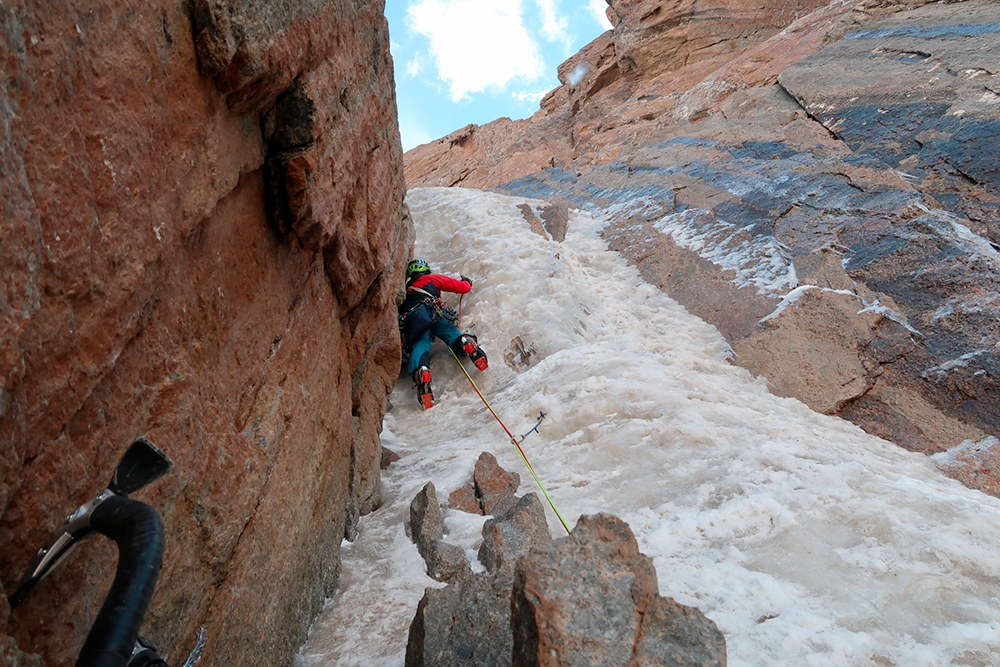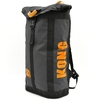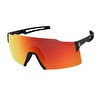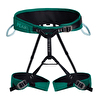Dry Ice Queen on Mount Zabor, difficult Slovakian mixed climb in Kyrgyzstan

 1 / 6
1 / 6 Juraj Svingal / Marek Radovsky
Juraj Svingal / Marek Radovsky
Last year, we got our first taste of Kyrgyzstan. We had planned to repeat the Polish route on Verniy Peak in the Kookshal Too mountain range close to Kyzyl Asker and to look for other possible first ascents. From the information and photographs available, it seemed like there could be some interesting projects. And it turned out to be true. The walls around Kyzyl Asker offer amazing mixed and rock climbing up to 5000-6000m and on one of these, Vernyi Peak, Lukáš Bulla, Juraj Švingál and I established our Slovak Route. Graded M7- Wi5 and 650m high, the route ends below the most prominent tower visible from the valley.
As there was no time for acclimatisation this year, we tried a hyperbaric chamber. It is harder to acclimatise in the valley when you are dropped off at 3800mm. Admittedly, the chamber helped.
After two days in BC, we packed and headed up. We went a little overboard, thinking we could compete with Sherpas, and ended up hauling our 30kg packs on our backs for 8km. Once we arrived, we realized the conditions were deplorable.
The line that we had seen last year was still beautiful, but its white cover was more revealing than we would have liked. Unfortunately, the line had melted. So we decided to climb 300m up the east side of Vernyi Peak to the valley of the Unmarked Soldier Peak (5352m).
We were slowly ascending the steep glacier with our heavy backpacks when a storm hit. We didn’t want to waste any time placing pro and luckily we made it up there safely. The sun set slowly, and so did our hopes. Not even the additional 300 vertical meters stopped the effects of the extremely warm weather. It wasn’t what we were hoping for. No ice, just loose snow.
We were tired and frustrated. While pitching our tent, we were “helped out”by some strong winds, which made the cooking extremely enjoyable. The night was hard and the wind did not subside, showing us who the real boss was. In the morning, the cloud cover made us rethink our long morning rituals. We packed our stuff and rappelled down to the glacier. We left our stuff under the wall and ran down to BC in frustration. There, we stared blankly into bottom of our cups of buckthorn tea. That is, hot water with buckthorn honey.
What were we going to do? All our plans had melted! I didn’t know. Mark brought his climbing shoes, and I tried them on with thick socks. They kind of fit. As the conditions for mixed climbing were very limited, we started thinking about doing some rock climbing. After two days in BC, we hiked up again. We looked up the walls, hoping to find some good conditions. But the glacier was just a big swamp. Terrible.
In the end, we decided on two variants. The first one was rock climbing with a glacier finish. And if that didn’t work out, we would climb the eastern wall of Zabor, just opposite Vernyi Peak. The same evening, we started up the rock wall to see if it was any good. But apparently, one pair of climbing shoes and one set of friends with just one #6 Camalot is not enough. So we opted for the second variant, the eastern wall of Zabor.
We packed light. No bivouac gear, no stove. We only took 1 litre of water per person and a drill with bolts. We didn't really believe that we could climb the rock section in the middle of the wall via a logical line, although we studied the face carefully with a pair of binoculars. Furthermore, our goal was not to climb the wall at any cost, but only if it was enjoyable.
The alarm went off in the morning and the adventure began. According to the forecast, it was supposed to be a clear day. That worried us a little bit, as the wall was in the sun the whole morning. Fortunately, the forecast was wrong, and it turned out to be cloudy. We simul-climbed the first 150 meters. We set the first anchor under an unusual ice overhang that the warm temperatures created in the upper section. If we wanted to climb it, we first needed to crawl underneath it, as if into a cobra’s mouth. Then it was only up to our climbing skill to get on top of it. Marek fought like a knight. And, fortunately, his fight had a fairy-tale happy ending. For me, not so much. As I was taking pictures of him, a huge chunk of ice landed on my hand. Luckily, apart from some blood and a couple of scratches, I was fine, and we were able to continue. But my hand hurt, and I did not feel confident to lead.
Marek took it upon himself and fought like a tiger. He led one sketchy pitch after the next. When I reached the crux, which we had studied carefully from below, I just stared in disbelief at the endless slab and the overhangs above it. Marek brought me back to the reality with his: "I know how to do it, just tell me if you can see a crack in that corner". In difficult situations, one just needs a little hope to overcome even the insurmountable. And this is where Marek and I really connect. We know how to encourage each other in difficult moments. It was very important for us to trust each other. "Marek, there is a crack, I think it’s doable, even in crampons, though it won't be easy". I wanted to help, but my hand was still hurting, so Marek pushed on without hesitation. He managed to place protection, which was the important part. But he couldn't reach the corner where I saw the crack. “Marek, grab the undercling with your ice axe and try to stand up." Those kind of moves are always the hardest, there is no going back, you have to trust that the ice axe will hold, that the protection will hold, and you will be able to place another piece of gear higher up, otherwise you will experience a nasty fall onto the ledge. Marek succeeded and reached the crack in the corner and placed some pro. But the fight was not over. After an hour, Marek finally established a belay. Incredibly, we were a one step closer to the summit. But there were still a couple of pitches left before we could reach the upper section, where we were expecting to encounter ice and firn. From there, we had no idea how we would get onto the ridge.
We still had a long way to go. Marek led another two gnarly pitches. When he had had enough, I took over. We still had to figure out to how to get past another crux. The corner we wanted to climb was glazed with ice, with water running down it. Marek tried to look around the corner, it seemed like there could be a platform above us, leading to the ice section. “It looks like there could be a way, but you try it.” And I did. I got to the end of the platform and just needed to climb down a bit to reach the ice section. Marek was determined. It would have been a beautiful pitch if the conditions were right. The ice didn't hold, there was nowhere to place protection. But he made it just before the darkness set in.
At this point we considered our next options. We’d run ran out of water a long time ago, and we only had one bar left. We were physically and mentally exhausted. "I'm going to give it a try, Marek." I switched on my headlamp and headed up. There was a beautiful steep firn corner. But then reality set in. I was climbing on nothing but a thin, chossy “waffle”. And then another surprise. At the end, there was no more “waffle”, just “whipped cream”. That feeling when you're standing on nothing and digging your way up in the snow 700m above the ground is not very appealing. So you turn on the “rescue mode” and somehow soldier on. Hooray, found a place for an anchor!
One more annoying steep ice climb, though in the light of headlamps, it looked unclimbable. Whatever. After the ice section, there was only one question left - can we make it to the ridge? There was a choosy corner with an off-width. We thought we were close to the ridge. Based on the photos, maybe 1 to 2 pitches away. The terrain was loose, and we were fed up. We could probably make it in one pitch but decided for 2 shorter ones. And then suddenly we’d made it onto the ridge! And then reality set it. We needed to descend. We started rapelling down. It went pretty well, the drill worked great. The ropes didn't get stuck and after a couple of hours we made it down. Slowly we reached the tent. We boiled water, drank, and lay down, almost at daybreak.
A few hours of sleep were enough to recharge batteries for the trip to BC. Down there, it’s easier to rest and replenish fluids. For that occasion, we had set aside an amazing watermelon. It's great when you need to rehydrate and refuel on sugar And, of course, there was beer waiting for us, which kept me afloat. We ate, drank, and slowly realised what we’d just achieved. What an amazing feeling.
Then we decided that it would be nice to summit Zabor in broad daylight. There was a glacier on its west side, though it did not look very appealing from below. But it could be a relatively quick climb to the top of Zabor. At least that’s what we thought. It turned out to be a maze through bus-sized crevasses. And a couple of pitches of climbing.
It did work out though and we reached the summit. The original plan was to go down the glacier, but we didn't want to it risk again. And so we rappelled down the wall. It would have been pleasant, had it not been for the storm. Though we were quite lucky, as the weather was supposed to be bad all day that day but turned out quite good until 4 p.m. In the end, a short hike on the glacier turned into a 12-hour cardio exercise. When we crawled back to our tent, it had stopped snowing. We made a cappuccino and packed quickly. Once we put the backpacks on, we had one last mission.
The backpacks weighed more than we would have liked, but we had to go down somehow. Saying goodbye to a valley is always a very emotional moment for me. But my heavy backpack pushed me on.
Three hours later, we were back at our teepee. It was time to celebrate – with our second watermelon. Yaks were invited too but showed no interest, so it was just the two of us. There was only one thing left: to hope that we’d get picked up at an arranged time. After having waited for an hour, we got up to look for our ride. It seemed like a futile exercise at first, but eventually our Delica arrived. Hooray, we were safe!
I would like to thank everyone who supported our expedition to Kyrgyzstan. We thank our loved ones and families for being patient with us, and everyone else who has helped. A big thank you goes to our sponsors, especially to SHS James. And thank you to my oldest daughter, who forgave me for not attending her birthday party, though I know it will cost me dearly.
This first ascent wouldn’t have been possible without our sponsors and supporters. SHS James - financial support, MARVA - awesome bars from an awesome guy, Sun on the Rocks - Mario Piťuch - financial support, Žilmonts.r.o. - Boris Ruman - super ropes, town Handlová - financial support, ABC Food machinery - financial support, HK Prometeus Handlová - financial support
by Juraj Švingál



 Copia link
Copia link




 See all photos
See all photos


























